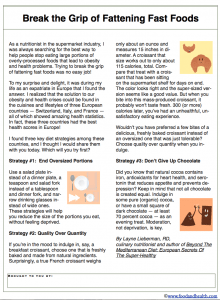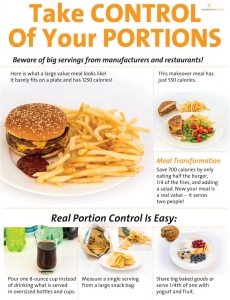Break the Grip of Fattening Fast Foods
As a nutritionist in the supermarket industry, I was always searching for the best way to help people stop eating large portions of overly-processed foods that lead to obesity and health problems. Trying to break the grip of fattening fast foods was no easy job!To my surprise and delight, it was during my life as an expatriate in Europe that I found the answer. I realized that the solution to our obesity and health crises could be found in the cuisines and lifestyles of three European countries — Switzerland, Italy, and France — all of which showed amazing health statistics. In fact, these three countries had the best health scores in Europe!I found three key diet strategies among these countries, and I thought I would share them with you today. Which will you try first?Strategy #1: End Oversized PortionsUse a salad plate instead of a dinner plate, a teaspoon and salad fork instead of a tablespoon and dinner fork, and narrow drinking glasses instead of wide ones. These strategies will help you reduce the size of the portions you eat, without feeling deprived.Strategy #2: Quality Over QuantityIf you’re in the mood to indulge in, say, a breakfast croissant, choose one that is freshly baked and made from natural ingredients. Surprisingly, a true French croissant weighs only about an ounce and measures 15 inches in diameter. A croissant that size works out to only about 115 calories, total. Compare that treat with a croissant that has been sitting on the supermarket shelf for days on end. The color looks right and the super-sized version seems like a good value. But when you bite into this mass-produced croissant, it probably won’t taste fresh. 300 (or more) calories later, you’ve had an unhealthful, unsatisfactory eating experience.Wouldn’t you have preferred a few bites of a delicious, freshly baked croissant instead of an oversized one that was just tolerable? Choose quality over quantity when you indulge.Strategy #3: Don’t Give Up ChocolateDid you know that natural cocoa contains iron, antioxidants for heart health, and serotonin that reduces appetite and prevents depression?Keep in mind that not all chocolate is created equal. Indulge in some pure (organic) cocoa, or have a small square of dark chocolate — at least 70 percent cocoa — as an evening treat. Moderation, not deprivation, is key.By Layne Lieberman, MS, RD, CDN, Culinary Nutritionist and author of Beyond The Mediterranean Diet: European Secrets Of The Super-Healthy.Did you think I'd give you all that wonderful information without a free handout to go with it? Never fear! Here is the Break the Grip of Fattening Fast Foods handout. But wait, there's more! Check out these great portion control resources from the Nutrition Education Store!
But wait, there's more! Check out these great portion control resources from the Nutrition Education Store!




